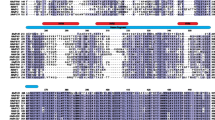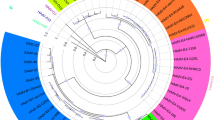Abstract
Seven adenovirus strains of subgenus D, related to adenovirus types 8, 10, 13, 19, 23, 24 and 26, but atypical in their serological reactions or in hemagglutinin properties, were characterized by neutralization and hemagglutination-inhibition. DNA restriction analysis with five endonucleases showed that each of the strains was strikingly different from the respective prototype.
Similar content being viewed by others
References
Adrian Th, Bastian B, Benoist W, Hierholzer JC, Wigand R (1985) Characterization of adenovirus 15/H9 itermediate strains. Intervirology 23:15–22
Adrian Th, Heinrich W (1986) COMAP: a comigrating analysis program for estimating the relationship of adenoviruses on the genome level. Nucleic Acids Res 14:559–565
Adrian Th, Wadell G, Hierholzer JC, Wigand R (1986) DNA restriction analysis of adenovirus prototypes 1 to 41. Arch Virol 91:277–290
Blacklow NR, Hoggan MD, Austin JB, Rowe WP (1969) Observations on two new adenovirus serotypes with unusual antigenic characteristics. Am J Epidemiol 90:501–505
Brown M, Petric M, Middleton PJ (1984) Silver staining of DNA restriction fragments for the rapid identification of adenovirus isolates: Application during nosocomial outbreaks. J Virol Methods 9:87–98
De Jong JC, Wigand R, Adrian Th, Hierholzer JC, Kapsenberg JG, Muzerie CJ, Wermenbol AG (1984) Adenovirus 38: a new human adenovirus species of subgenus D. Intervirology 22:164–169
Fujii SI, Nakazono N, Sawada H, Ishii K, Kato M, Aoki K, Ohtsuka H, Fu**aga K (1983) Restriction endonuclease cleavage analysis of adenovirus type 8: Two new subtypes from patients with epidemic keratoconjunctivitis in Sapporo, Japan. Jap J Med Sci Biol 36:307–313
Hierholzer JC (1973) Further subgrou** of the human adenoviruses by differential hemagglutination. J infect Dis 128:541–550
Kemp MC, Hierholzer JC, Cabradilla CP, Obijeski JF (1983) The changing etiology of epidemic keratoconjunctivities: antigenic and restriction enzyme analyses of adenovirus types 19 and 37 isolated over a ten year period. J infect Dis 148:24–33
Nötzel R, Adrian Th, Wigand R, Wadell G (1985) Characterization of hemagglutinin variant strains of adenovirus 15 and 9. Arch Virol 85:171–174
Pettersson U (1984) Structural and nonstructural adenovirus proteins. In Ginsberg HS (ed) The adenoviruses. Plenum, New York, pp 205–270
Rowe WP, Hartley JW, Huebner RJ (1958) Serotype composition of the adenovirus group. Proc Soc Exp Biol Med 97:465–470
Wadell G (1984) Molecular epidemiology of adenoviruses. Curr Top Microbiol Immunol 110:191–220
Wadell G, De Jong JC (1980) Restriction endonucleases in identification of a genome type of adenovirus 19 associated with keratoconjunctivities. Infect Immun 27:292–296
Wadell G, Varsanyi T, Lord A, Sutton RNP (1980) Epidemic outbreaks of adenovirus 7 with special reference to the pathogenicity of adenovirus genome type 7b. Am J Epidemiol 112:619–628
Wigand R (1968) Serologische Beziehungen der Adenoviren der Gruppe II. Arch ges Virusforsch 23:40–47
Wigand R, Adrian Th (1986) Classification and epidemiology of adenoviruses. In: Doerfler W (ed) Adenovirus DNA. The viral genome and its expression. Martinus Nijhoff, Boston Dordrecht Lancaster, pp 409–441
Wigand R, Bartha A, Dreizin RS, Esche H, Ginsberg HS, Green M, Hierholzer JC, Kalter SS, McFerran JB, Pettersson U, Russell WC, Wadell C (1982) Adenoviridae: Second report. Intervirology 18:169–176
Wigand R, Bauer H (1964) Über den cytopathogenen Effekt der Adenoviren des Menschen. Arch Virusforsch 14:674–682
Wigand R, Fliedner D (1968) Serologically intermediate adenovirus strains: a regular feature of group II adenoviruses. Arch Virusforsch 24:245–256
Wigand R, Gelderblom H, Özel M, Distler H, Adrian Th (1983) Characteristics of Mastadenovirus h 8, the causative agent of epidemic keratoconjunctivitis. Arch Virol 76:307–319
Wigand R, Keller D, Werling I (1982) Immunological relationship among human adenoviruses of subgenus D. Arch Virol 72:199–209
Author information
Authors and Affiliations
Additional information
Aided by grants from the following institutions: Bundesministerium für Jugend, Familie, Frauen und Gesundheit, FRG; Fördererverein der Deutschen Vereinigung zur Bekämpfung der Viruskrankheiten e. V., München, FRG; Deutsche Forschungsgemeinschaft (Wi 3/21)
Rights and permissions
About this article
Cite this article
Adrian, T., Best, B. & Wigand, R. Serologically atypical adenovirus strains of subgenus D are different in their genome from the respective prototypes. Med Microbiol Immunol 176, 217–224 (1987). https://doi.org/10.1007/BF00196689
Received:
Issue Date:
DOI: https://doi.org/10.1007/BF00196689




